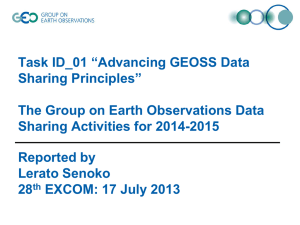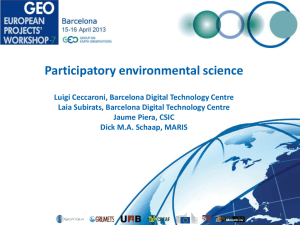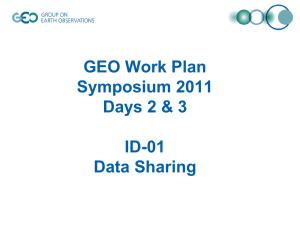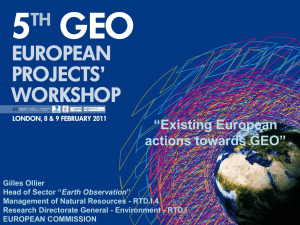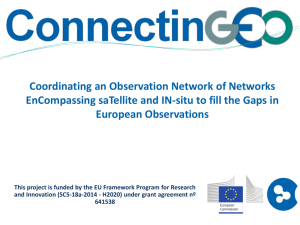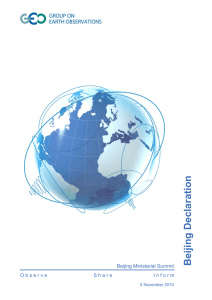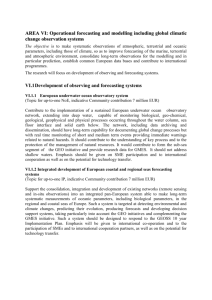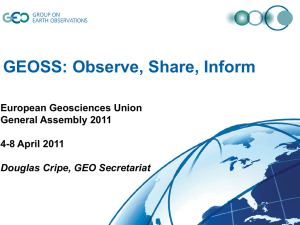THE GLOBAL EARTH OBSERVATION SYSTEM OF SYSTEMS (GEOSS):
advertisement
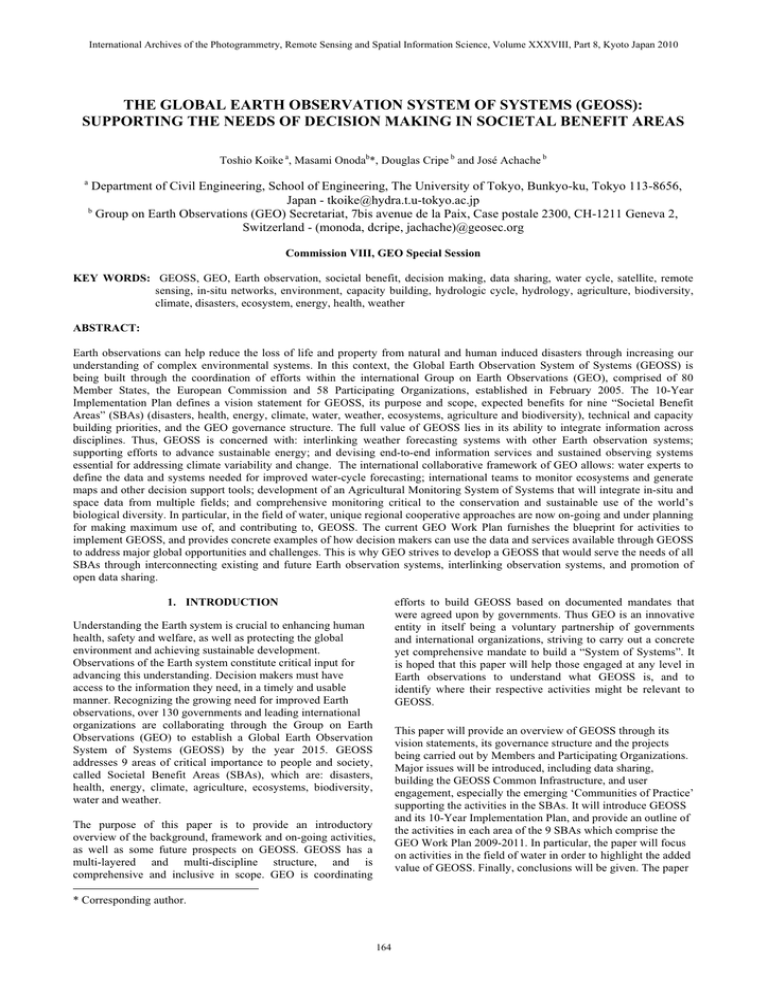
International Archives of the Photogrammetry, Remote Sensing and Spatial Information Science, Volume XXXVIII, Part 8, Kyoto Japan 2010 THE GLOBAL EARTH OBSERVATION SYSTEM OF SYSTEMS (GEOSS): SUPPORTING THE NEEDS OF DECISION MAKING IN SOCIETAL BENEFIT AREAS Toshio Koike a, Masami Onodab*, Douglas Cripe b and José Achache b a Department of Civil Engineering, School of Engineering, The University of Tokyo, Bunkyo-ku, Tokyo 113-8656, Japan - tkoike@hydra.t.u-tokyo.ac.jp b Group on Earth Observations (GEO) Secretariat, 7bis avenue de la Paix, Case postale 2300, CH-1211 Geneva 2, Switzerland - (monoda, dcripe, jachache)@geosec.org Commission VIII, GEO Special Session KEY WORDS: GEOSS, GEO, Earth observation, societal benefit, decision making, data sharing, water cycle, satellite, remote sensing, in-situ networks, environment, capacity building, hydrologic cycle, hydrology, agriculture, biodiversity, climate, disasters, ecosystem, energy, health, weather ABSTRACT: Earth observations can help reduce the loss of life and property from natural and human induced disasters through increasing our understanding of complex environmental systems. In this context, the Global Earth Observation System of Systems (GEOSS) is being built through the coordination of efforts within the international Group on Earth Observations (GEO), comprised of 80 Member States, the European Commission and 58 Participating Organizations, established in February 2005. The 10-Year Implementation Plan defines a vision statement for GEOSS, its purpose and scope, expected benefits for nine “Societal Benefit Areas” (SBAs) (disasters, health, energy, climate, water, weather, ecosystems, agriculture and biodiversity), technical and capacity building priorities, and the GEO governance structure. The full value of GEOSS lies in its ability to integrate information across disciplines. Thus, GEOSS is concerned with: interlinking weather forecasting systems with other Earth observation systems; supporting efforts to advance sustainable energy; and devising end-to-end information services and sustained observing systems essential for addressing climate variability and change. The international collaborative framework of GEO allows: water experts to define the data and systems needed for improved water-cycle forecasting; international teams to monitor ecosystems and generate maps and other decision support tools; development of an Agricultural Monitoring System of Systems that will integrate in-situ and space data from multiple fields; and comprehensive monitoring critical to the conservation and sustainable use of the world’s biological diversity. In particular, in the field of water, unique regional cooperative approaches are now on-going and under planning for making maximum use of, and contributing to, GEOSS. The current GEO Work Plan furnishes the blueprint for activities to implement GEOSS, and provides concrete examples of how decision makers can use the data and services available through GEOSS to address major global opportunities and challenges. This is why GEO strives to develop a GEOSS that would serve the needs of all SBAs through interconnecting existing and future Earth observation systems, interlinking observation systems, and promotion of open data sharing. efforts to build GEOSS based on documented mandates that were agreed upon by governments. Thus GEO is an innovative entity in itself being a voluntary partnership of governments and international organizations, striving to carry out a concrete yet comprehensive mandate to build a “System of Systems”. It is hoped that this paper will help those engaged at any level in Earth observations to understand what GEOSS is, and to identify where their respective activities might be relevant to GEOSS. 1. INTRODUCTION Understanding the Earth system is crucial to enhancing human health, safety and welfare, as well as protecting the global environment and achieving sustainable development. Observations of the Earth system constitute critical input for advancing this understanding. Decision makers must have access to the information they need, in a timely and usable manner. Recognizing the growing need for improved Earth observations, over 130 governments and leading international organizations are collaborating through the Group on Earth Observations (GEO) to establish a Global Earth Observation System of Systems (GEOSS) by the year 2015. GEOSS addresses 9 areas of critical importance to people and society, called Societal Benefit Areas (SBAs), which are: disasters, health, energy, climate, agriculture, ecosystems, biodiversity, water and weather. This paper will provide an overview of GEOSS through its vision statements, its governance structure and the projects being carried out by Members and Participating Organizations. Major issues will be introduced, including data sharing, building the GEOSS Common Infrastructure, and user engagement, especially the emerging ‘Communities of Practice’ supporting the activities in the SBAs. It will introduce GEOSS and its 10-Year Implementation Plan, and provide an outline of the activities in each area of the 9 SBAs which comprise the GEO Work Plan 2009-2011. In particular, the paper will focus on activities in the field of water in order to highlight the added value of GEOSS. Finally, conclusions will be given. The paper The purpose of this paper is to provide an introductory overview of the background, framework and on-going activities, as well as some future prospects on GEOSS. GEOSS has a multi-layered and multi-discipline structure, and is comprehensive and inclusive in scope. GEO is coordinating * Corresponding author. 164 International Archives of the Photogrammetry, Remote Sensing and Spatial Information Science, Volume XXXVIII, Part 8, Kyoto Japan 2010 (SBA) of GEOSS include: disaster mitigation, health, energy, climate, water, weather, ecosystems, agriculture, and biodiversity. will be based on an interdisciplinary approach in order to answer the question of how decision making could be enhanced through information provided by Earth observations. The 2009-2011 GEO Work Plan (Group on Earth Observations, 2009) provides the agreed framework for implementing the GEOSS 10-Year Implementation Plan. The 2009-2011 Work Plan takes the GEOSS 10-Year Implementation Plan up to and beyond its mid-way point. While the first phase of GEOSS development, from 2005 to 2008, focused on building the GEO community and engaging countries and organizations, the next phase will increasingly focus on actually putting the components of GEOSS into place. This phase of the plan will enable connections to be realized between diverse observing, processing, data-assimilation, modeling and informationdissemination systems. 2. GEOSS: AN INNOVATIVE APPROACH TO SUPPORT INFORMATION FOR DECISION MAKING 2.1 A “System of Systems” Approach and GEO “System of systems” is a term that has become a driving concept for the global Earth observation strategy today. In recent years, there has been a growing recognition that significant changes need to be made in governments and industries, especially in the aerospace and defence areas, as now solutions are wanted to provide a set of capabilities, not a single specific vehicle or system to meet an exact set of specifications. Although there is not a commonly accepted definition on system of systems, it is suggested that the emerging system of systems context arises when a need or set of needs are met with a mix of multiple systems, each of which are capable of independent operation but must interact with each other in order to fulfil the global mission or missions (Crossley, 2004). Others say that there is an emergent class of systems which are built from components which are large scale systems in their own right, for example, integrated air defence networks, the Internet, intelligent transport systems, and enterprise information networks (Maier, 1998). 3. CROSS-CUTTING ISSUES The GEO 10-Year Implementation Plan identifies several functional components including: (1) Addressing identified common user requirements; (2) acquiring observational data; processing data into useful products; (3) exchanging, disseminating, and archiving shared data, metadata and products; and (4) monitoring performance against the defined requirements and intended benefits. These issues are dealt in the GEO Work Plan through the 4 “Transverse Areas” of Architecture, Data, Capacity Building, Science and Technology, and User Engagement. In the following, this paper will focus on the GEOSS Data Sharing Principles, the GEOSS Common Infrastructure that supports the exchange of data through the GEOSS, and a “Community of Practice” approach to engage users. GEO – a body that coordinates efforts to build a Global Earth Observation System of Systems - or GEOSS – was established in February 2005, after the World Summit on Sustainable Development (WSSD), the Group on Eight leading industrialized countries (G8), and three ministerial Earth Observation Summits called for improving the world’s observation systems. The “System of Systems” thus interconnects existing and planned observation systems from around the world and supports the development of new systems where gaps currently exist. GEO is a voluntary partnership of governments and international organizations, and is charged with implementing GEOSS, designed to ultimately provide decision-support tools to a wide variety of users. Some regard GEO as being technically an intergovernmental meeting but virtually close to a small-scale intergovernmental organisation (Aoki, 2006). It is thus an innovative approach to international coordination that provides a framework for these partners to develop new projects and coordinate their strategies and investments. 3.1 Data Sharing The 10-Year Implementation Plan states that societal benefits of Earth observations cannot be achieved without data sharing, and establishes the GEOSS Data Sharing Principles: (1) There will be full and open exchange of data, metadata and products within the GEOSS, recognizing relevant international instruments and national policies and legislation; (2) All shared data, metadata and products will be made available with minimum time delay and minimum cost; (3) All shared data, metadata and products being free of charge or no more than cost of reproduction will be encouraged for research and education. Data sharing is of fundamental importance in the implementation of the GEOSS. 2.2 The 10-year Implementation Plan and GEO Work Plan The Cape Town Ministerial Summit in 2007 supported the establishment of a process with the objective to reach a consensus on the implementation of the Data Sharing Principles for GEOSS, to be presented at the next GEO Ministerial Summit (Group on Earth Observations, 2007). The GEO-VI Plenary accepted the Implementation Guidelines for the GEOSS Data Sharing Principles that provide the foundation for the proposed Action Plan which is currently under review by GEO Members. The achievement of full and open exchange of, and access to, key datasets will require actions by GEO collectively and by Members and Participating Organizations individually, and by GEOSS tasks and cross-cutting activities. The GEOSS 10-Year Implementation Plan (Group on Earth Observations, 2005) was endorsed at the Third Earth Observation Summit in Brussels, in April 2005. GEO is constructing GEOSS on the basis of a 10-Year Implementation Plan (Group on Earth Observations, 2005) for the period 2005 to 2015. The Plan is based upon the negotiations held at three ministerial Earth Observation Summits. In this Plan, it is recognized that “the current situation with respect to the availability of Earth observations is not optimal,” particularly in “coordination and data sharing among countries, organizations and disciplines, and meeting the needs of sustainable development.” The intended benefit of GEOSS is a the “targeted collective action” that it would bring this coordination and data sharing about. The Societal Benefit Areas 165 International Archives of the Photogrammetry, Remote Sensing and Spatial Information Science, Volume XXXVIII, Part 8, Kyoto Japan 2010 as wildland fires, volcanic eruptions, earthquakes, tsunamis, subsidence, landslides, avalanches, ice, floods, extreme weather, and pollution events. GEOSS is to bring a more timely dissemination of information through better coordinated systems for monitoring, predicting, risk assessment, early warning, mitigating, and responding to hazards at local, national, regional, and global levels. The GEO 2009-2011 Work Plan implements these visions through tasks including: Use of Satellites for Risk Management; Systematic Monitoring for Geohazards Risk Assessment; Multi-Risk Management and Regional Applications; and Warning Systems for Disasters. For instance, the GEO ‘Supersite’ initiative provided rapid response to the recent earthquakes in Haiti and Chile, where satellite data and data sets were posted for researchers to use and share, including seismic maps, damage maps, and interferograms. 3.2 The GEOSS Common Infrastructure The GEOSS Common Infrastructure (GCI) allows the user of Earth observations to access, search and use the data, information, tools and services available through GEOSS. The infrastructure consists of four main elements: The GEO Web Portal, the GEOSS Clearinghouse, the GEOSS Components and Services Registry, and the GEOSS Standards and Interoperability Registry. GEO being a voluntary partnership, each element of the GEOSS Common Infrastructure has been voluntarily contributed. The goal of the GCI is to make each of the systems comprising GEOSS fully interoperable. Further, since GEOSS is a system of systems, to the GCI aims to reduce costs, promote international cooperation and serve the public good. It also aims to enable users to access and combine observations from multiple systems across SBAs, and to share with others. It is essential that the GCI, as the architectural framework of GEOSS, support these objectives, and that it be developed and maintained in consistency with the Data Sharing Principles. 4.2 Health To understand environmental factors affecting human health and well-being, it is envisioned that GEOSS will improve the flow of appropriate environmental data and health statistics to the health community, promoting a focus on prevention and contributing to continued improvements in human health worldwide. The first initiative in the GEOSS Health SBA is to develop a global public-health information network database. The priority effort is to connect the Open Health information tool of World Health Organization (WHO) and other health and environmental information systems to the GEO Portal and the GCI. The second component is to connect established and emerging systems for monitoring and prediction useful for decision-makers in the health sector. These activities are making progress on a variety of fronts, notably sand and dust storm warning, persistent organic pollutants monitoring, and global atmospheric mercury monitoring. The third component of the Health SBA is to develop and implement end- to-end health-environment projects to advance the application of observation, monitoring and forecasting systems to health decision-making processes. Among the existing projects are: a meningitis decision-support tool; a globally coordinated malaria warning system; and decision-support tools and research on ecosystems, biodiversity and health, focusing on Lyme disease. More are proposed, including dengue fever and vibrio diseases. The GCI Coordinating Team is in the process of selecting a single Clearinghouse and a single Web Portal for the GCI. In particular, two test teams have been formed, detailed test procedures have been defined, and all planned tests have been executed. The functional test team has been formed by the European Commission’s Joint Research Centre and the Brazilian Space Agency INPE, and the usability test team has been set up by the US Environmental Protection Agency. In July 2010, the GCI Coordinating Team will submit its recommendations for the selection. 3.3 Engaging Users – the GEO Communities of Practice In order to realize the benefits of GEOSS globally by a broad range of user communities, including managers and policy makers, scientific researchers and engineers, civil society, governmental and non-governmental organizations and international bodies, GEO organizes user-oriented fora, making use of groups known as the ‘Community of Practice’. A Community of Practice is defined as a user-led community of stakeholders, from providers to the final beneficiaries of Earth observation data and information, with a common interest in specific aspects of societal benefits to be realized by GEOSS implementation. 4.3 Energy In order to improve management of energy resources, GEOSS outcomes are to support: environmentally responsible and equitable energy management; better matching of energy supply and demand; reduction of risks to energy infrastructure; more accurate inventories of greenhouse gases and pollutants and a better understanding of renewable energy potential. There are three arms to the GEOSS energy SBA: First, management of energy sources to support the development of EO products and services for the resource assessment, monitoring and forecasting of fluctuating energy sources including hydro, solar, wind and ocean. The second is an energy environmental impact monitoring, to promote the development of Earth observation systems for monitoring and prediction of environmental impact from energy resource exploration, extraction, transportation and/or exploitation, building on the European project EnerGEO. The third is energy policy planning, to encourage the use of EO for informed energy-policy planning in developing and developed countries. Currently the following Communities of Practice are being developed under GEO: Air Quality, Atmospheric Chemistry, Biodiversity, Carbon, Coastal Zone, Cryosphere, Energy, Forest, Geohazards, Global Agricultural Monitoring, and Water Cycle. Although there is not necessarily a one-to-one correspondence with each of the SBAs, these groups of people are working to identify, gather, and seek agreement on their particular user community requirements, and to provide a forum for cooperation of activities where GEOSS adds value to existing initiatives, thereby supporting the activities and progress in various SBAs. 4. GEOSS SOCIETAL BENEFIT AREAS 4.1 Disasters Earth observations can help to reduce the loss of life and property from natural and human-induced disasters, such 166 International Archives of the Photogrammetry, Remote Sensing and Spatial Information Science, Volume XXXVIII, Part 8, Kyoto Japan 2010 forecast products. Efforts to improve the value of weather forecasting include the WMO-led THORPEX Interactive Global Grand Ensemble project, or TIGGE, which aims to accelerate improvements in the accuracy of one-day to twoweek weather forecasts. 4.4 Climate For understanding, assessing, mitigating and adapting to climate variability and change, GEOSS is to enhance the capacity to model, mitigate and adapt to climate change and variability. End-to-end information services and sustained observing systems are essential for addressing climate variability and change. There are four initiatives in the Climate SBA: First is a climate record for assessing variability and change is to ensure the development of international mechanisms to coordinate and maintain sustained climate data reprocessing and reanalysis efforts, and to support and coordinate activities towards a global coverage of high-resolution, well-dated reconstructions of past climate parameters in the ocean and on land. Second is environmental information for decision-making, risk management and adaptation, to support the integration of climate and environmental risk management into adaptation process, and to coordinate and drive the development of climate products and services, encouraging the use of this information by decision makers. Third is accelerating the implementation of the Global Climate Observing System (GCOS) through enhanced support for the component systems of GCOS. Finally, GEO is working to implement a global carbon observation and analysis system addressing the three components of the carbon cycle: atmosphere, land and ocean. It is providing high-quality regional information on CO2 and CH4 concentrations and emission variations, and will combine observations, reanalysis and product evaluation. The Forest Carbon Tracking initiative is an effort to coordinate the definition, development and validation of tools and methodologies for the evaluation of carbon storage in forests. 4.7 Ecosystems To improve the management and protection of terrestrial, coastal and marine resources, observations are needed detailing the area, condition, and natural-resource stock levels of ecosystems such as forests, rangelands, and oceans. GEOSS implementation seeks to ensure that methodologies and observations are available on a global basis to detect and predict changes in ecosystem condition and to define resource potentials and limits. The Ecosystems SBA consists of two major areas: First, the Ecosystem Observation and Monitoring Network (GEO EcoNet) and Ecosystem Vulnerability to Global Change. The GEO EcoNet includes efforts to produce a standardized classification and map of global ecosystems; to coordinate the collection, processing and distribution of biogeophysical and land surface parameter data; to extend a South American network for monitoring ocean temperatures and chlorophyll to the global scale; to advance characterization, mapping and monitoring of global protected areas consisting of UNESCO World Heritage sites and biosphere reserves; and to integrate international efforts on assessment and monitoring of forests. The second area is to assess the risks by human development to the environment, society and regional economies, including measuring the impact of tourism and other socio-economic activities on ecosystems; assessing the vulnerability of sea basins; and assessing the vulnerability of mountain regions. 4.5 Water For improving water-resource management through better understanding of the water cycle, GEOSS implementation is working to improve integrated water-resource management by bringing together observations, prediction, and decision-support systems and by creating better linkages to climate and other data. Water experts are collaborating through GEO to define the data and systems needed for improved water-cycle forecasting. National meteorological and hydrological services, along with several United Nations agencies, are collaborating through GEO’s “Integration of In-Situ and Satellite Data for Water Cycle Monitoring” project. This project aims to fill gaps in global measurements, standardize metadata, and improve the accuracy of data and predictions. Other ongoing initiatives relate to information products on precipitation, soil moisture, and groundwater. Additionally, capacity building activities are ongoing in Asia, Africa, and Latin America & Caribbean to demonstrate the value of Earth observations in water resource management while developing tools and know-how for using remote sensing data in support of water management (see Section 5 below). 4.8 Agriculture The GEO Agriculture SBA is addressing the application of Earth observations in agriculture, forestry and fishery areas, in support of the sustainable agriculture. GEO is developing a Global Agricultural Monitoring System of Systems which includes three main functional components: Global mapping and monitoring of changes in distribution of cropland area and the associated cropping systems; Global monitoring of agricultural production leading to accurate and timely reporting of national agricultural statistics, accurate forecasting of shortfalls in crop production and food supply, and facilitating reduction of risk and increased productivity at a range of scales; and effective early warning of famine, enabling the timely mobilization of an international response in food aid. GEO is promoting the data utilization in fisheries and aquaculture by identifying opportunities for the enhanced utilization of Earth observations in fisheries and aquaculture, through the implementation of the Societal Applications in Fisheries and Aquaculture using Remotely-sensed Imagery (SAFARI) project and the International Ocean Colour Coordinating Group (IOCCG) monograph, and providing products related to marine ecosystems and ocean biogeochemistry for near-surface global ocean and coastal waters to end-users. 4.6 Weather GEOSS is interlinking weather forecasting systems with other Earth observation systems. The weather observations encompassed by GEOSS are based on the requirements for timely short- and medium-term forecasts. GEOSS can help fill critical gaps in the observation of, for example, wind and humidity profiles, precipitation, and data collection over ocean areas; extend the use of dynamic sampling methods globally; improve the initialization of forecasts; and increase the capacity in developing countries to deliver essential observations and use 4.9 Biodiversity For the understanding, monitoring and conservation of biodiversity, issues in this area include the condition and extent of ecosystems, distribution and status of species, and genetic diversity in key populations. GEOSS implementation aims to unify many disparate biodiversity-observing systems and create 167 International Archives of the Photogrammetry, Remote Sensing and Spatial Information Science, Volume XXXVIII, Part 8, Kyoto Japan 2010 a platform to integrate biodiversity data with other types of information. The GEO Biodiversity Observation Network is interlinking the field’s numerous databases and observation systems to improve assessments of plant and animal populations, track the spread of invasive alien species, and promote information sharing and cost savings. It will also connect these systems to other Earth observation networks that generate relevant data, such as climate and pollution indicators. With the support of the science communities, including the Coordinated Energy and Water Cycle Observation Project (CEOP) of the Global Energy and Water Cycle Experiment (GEWEX) and the 3rd Coupled Model Intercomparison Project (CMIP3) of the World Climate Research Programme (WCRP), the research-oriented integrated fields of observation data, satellite remote sensing data, numerical weather prediction model outputs, and climate prediction model outputs have been archived for data integration and information fusion. 5. REGIONAL APPROACHES TO WATER SBA Under the global Earth observation framework of GEO, there are two unique regional approaches taken in the tasks of the water SBA by considering regional commonalities in waterrelated problems, merits of regional cooperation under the GEO framework, and effective contributions to GEOSS. One is now on-going in Asia-Pacific and the other under planning in Africa. Through cooperation between the meteorology and hydrology operational sectors and the science communities, several distributed hydrological models, decision support systems for optimizing dam operations (to balance flood control and water usage), and emergency evacuation planning have already been developed using the archived data sets. Figure 2 shows one of the examples in Vietnam. The optimization system coupled with Earth observations demonstrates a successful dam operation which reduces the flood peak around Hanoi and leaves the water level at full reservoir capacity at the end of flood season. Figure 3 shows increase of inundation risk due to climate change by coupling the CMIP3 data sets and the distributed hydrological model. 5.1 GEOSS/Asian Water Cycle Initiative (AWCI) The GEOSS/AWCI develops an information system of systems for promoting the implementation of integrated water resources management (IWRM) through data integration and sharing. By improving our understanding and prediction of the water cycle and its variation, contributions to, and use of, GEOSS can be maximized, and thus serve as a basis for sound decision making with respect to national water policies and management strategies. The objectives for AWCI are defined as follows: to develop IWRM approaches; to share timely, quality, long-term information on water quantity and quality, and their variation as a basis for sound national and regional decision making; to construct a comprehensive, coordinated and sustained observational system of systems, such as prediction systems and decision support capabilities, under the GEOSS; to develop capacity building for making maximum use of globally integrated data and information for local purposes as well as for observation and collecting data. Figure 2 Optimized operation of the Hoa-Binh Dam and the river water level near at Hanoi. green line: actual, pink line: no optimization, blue line: optimization by using observed satellite rainfall with the rain gauge correction and the distributed hydrological model. Based on the agreement for an open data sharing policy clearly described in January 2007, each member country identified one river basin as a demonstration. Sixteen have already uploaded the data, nine have completed the quality check, and the meta data registration is now on-going by using the web-based data archiving supporting system, as shown in Figure 1, of the Data Integration and Analysis System (DIAS), Figure 3 Assessment of the increase of area and depth of inundation caused by 10 year probable flood from the current climate to 50 years later due to the climate change. To reduce prediction uncertainty, the average of the 17 climate prediction model outputs is used. Figure 1 Web-based data archiving supporting system of DIAS. which was developed by the University of Tokyo, Japan Aerospace Exploration Agency (JAXA), and Japan Agency for Marine-Earth Science and Technology (JAMSTEC), supported by the government of Japan as its contribution to GEOSS through the DA09-02a task of the 09-11 Work Plan. The GEOSS/AWCI is a new type of an integrated scientific challenge in cooperation with meteorological and hydrological bureaus and space agencies. Its uniqueness is described as follows: 168 International Archives of the Photogrammetry, Remote Sensing and Spatial Information Science, Volume XXXVIII, Part 8, Kyoto Japan 2010 Effective combination of interoperability architecture and data, and capacity building; Advanced data infrastructure availability including a river basin meta-data registration system, a data quality control interface, and data-integration and downscaling methods; A clearly described data sharing policy agreed among the participating countries; Strong linkage among science communities, space agencies, and decision makers; Well-coordinated collaboration between the research communities and operational sectors with clear strategy for transferring scientific achievements to operational use; Effective cooperation with international projects and cooperative frameworks. 6. CONCLUSIONS This paper provided an overview the activities of GEO, in particular focusing on initiatives within the Water SBA. The GEOSS 10-year Implementation Plan and its 2009-2011 Work Plan sets forth a framework where international collaboration is sought to coordinate and integrate Earth observation activities worldwide. The Communities of Practice are under development to further support these efforts. In order to improve the flow of environmental data to the SBAs, concerted efforts between the user communities and the observation data providers are needed, in order to identify user needs and to ensure appropriate information and data delivery. Data sharing is also of fundamental importance. Collective efforts building on the added-values of GEOSS, and utilizing functions such as the Communities of Practice, are essential to facilitate the process. The full value of GEOSS lies in its ability to integrate information across disciplines. This is why GEO strives to develop and implement a GEOSS that would serve the needs of all SBAs through interconnecting existing and future Earth observation systems, interlinking observation systems and open data sharing. GEOSS/AWCI is a regionally cooperative contribution to "Improving water resource management through better understanding of the water cycle". 5.2 GEOSS/African Water Cycle Coordination Initiative (AWCCI) Reliable access to water still cannot be completely assured in Africa. Simultaneously, the effects of flooding and droughts are resulting in large human and socio-economic losses. In addition, large fluctuations of regional and local water cycles are intensifying water scarcity, threatening freshwater ecosystems, and increasing water-related diseases and associated impacts on society. There is no need to restate the importance of water management in Africa, in particular to face adaptation to climate change. References from Journals: Maier, M., 1998. Architecting principles for system-of-systems. Systems Engineering, 1-4, pp. 267-284 References from Books: Aoki, S., 2006. Nihon no Uchu Senryaku (Japanese Space Strategy), Keio University Press, Tokyo, p. 309. Although we may recognize the commonality and regionality of water-related issues, as well as socio-economic impacts caused by water-related disasters such as floods, droughts and landslides, water scarcity, river and water environment degradation, and the effects of climate change overall, many initiatives, programs and projects designed to address these water-related issues in Africa are currently operating independently of one another. It is recognized that wellcoordinated initiatives along with a combination of global Earth observations and models using physical, chemical, biological and socio-economic information are essential to adequately address these issues. References from websites: Crossley, W., 2004. System of Systems: An introduction of Purdue University Schools of engineering’s Signature Area. Engineering Systems Symposium, Cambridge, USA. http://esd.mit.edu/symposium/pdfs/papers/crossley.pdf (accessed 31 May 2010) Group on Earth Observations, 2005. “The Global Earth Observation System of Systems (GEOSS) 10-Year Implementation Plan”. http://www.earthobservations.org/documents/10Year%20Implementation%20Plan.pdf (accessed 31 May 2010) The First African Water Cycle Symposium was held in Tunis, Tunisia, 5-7 January, 2009, hosted by the Tunis-based National School of Engineers (ENIT) and EcoPark Borj Cedria, a Tunisian organization on environmental issues, and the University of Tokyo, Japan. The Second African Water Cycle Coordination Symposium will be held in Addis Ababa, Ethiopia 14-16 September, 2010. Through these discussions, GEOSS provides fundamental services to support water management in Africa, including convergence and harmonization of observational activities, new techniques, interoperability arrangements, and effective and comprehensive data management to strengthen the various on-going and planned water-related activities in Africa. Demonstrating that the GEOSS is the appropriate tool for supporting this effort would be a proof-of-concept for GEO, the international Group on Earth Observations. Group on Earth Observations, 2007. “Cape Town Declaration”. http://www.earthobservations.org/05_Cape%20Town%20Decla ration.pdf (accessed 31 May 2010) Group on Earth Observations, 2009. “GEO 2009-2011 Work Plan”. http://www.earthobservations.org/documents/work%20plan/geo _wp0911_rev2_091210.pdf (accessed 31 May 2010) The Group of Eight Industrialized Nations, 2003. “Science and Technology for Sustainable Development – A G8 Action Plan”, Evian, France. http://www.g8.fr/evian/english/navigation/2003_g8_summit/su mmit_documents/science_and_technology_for_sustainable_dev elopment_-_a_g8_action_plan.html (accessed 31 May 2010) 169
